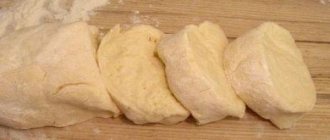Products that are frequently used and have a long shelf life are purchased for future use. These include flour, which can be kept in a house or apartment for a long time. This product is used in large quantities in the preparation of confectionery products. The minimum serving for baking is half a kilogram. Buying the product in large quantities is most profitable. How to properly store flour at home so that bugs do not infest it and excessive moisture does not spoil it.
Product storage features
For bulk formulations, it is important to maintain optimal temperature and humidity. Violation of these rules leads to the appearance of mold and mites. Meanwhile, storing flour at home has a long period if you create conditions for it.
If the product is stored in small factory-packaged paper bags, it is not recommended to open it long before use. On the contrary, it is recommended to check a large batch of flour in bags immediately. If you pour the product into a container where another batch has already been stored, you can spoil it by infecting it with bugs. They can also remain in old bags. A contaminated product may come from the manufacturer, so the product must be carefully inspected.
Under favorable conditions in the apartment, you can easily check for the presence of living creatures inside the product. It is necessary to sift a small amount of flour through a fine sieve. If there are no bugs left, then you can send the product for long-term maintenance. Flour storage conditions are as follows:
- maintaining optimal humidity,
- constant temperature without changes,
- strong packaging.
Storing flour at home requires a humidity level of no more than 60 percent. The temperature should be between 5 and 15 degrees plus. If significant fluctuations in indicators occur, the shelf life is significantly reduced.
A product made from different cereals of different grinding differs in composition. The fat content directly determines how long the flour is stored. The shelf life of each type at a temperature of 6 degrees may differ:
- 7 months for sorted wheat flour,
- 6 months for rye,
- soy and corn varieties last 6 months,
- deodorized soybean up to a year.
The most susceptible to bug infestation is the product made from 2nd grade wheat and wallpaper. Rye flour also has a high fat content.
Shelf life of flour at home
State standards give manufacturers the right to independently set expiration dates for flour. Only the grain processing enterprise must necessarily establish the production date and storage nuances. The average shelf life according to GOST data is 6-10 months. Highly purified products lie quietly for up to a year. But the type of cereal used also has an impact.
What container do you store flour in?
In bagsIn cans
What flour can be stored for up to a year:
- wheat;
- pea;
- bird cherry;
- from chickpeas.
Up to six months:
- rye;
- buckwheat;
- rice;
- barley flour.
The shortest shelf life is for ground corn and coconut. Also, do not leave pancake flour for a long time. It includes milk powder, egg powder, various cereals, improvers.
The more bran and plant husks in a product, the shorter the shelf life. These inclusions promote oxidation, resulting in a rancid taste and specific aroma. Therefore, whole grain varieties spoil faster.
The shelf life of wheat flour is 6-12 months. Other species are stored less often. Optimum temperature +5-25 degrees, humidity up to 70%. Choose dry places, protected from sunlight.
How to identify a quality product
To store flour, it is necessary that it is initially of high quality. In an unsealed container, you can see it and determine the presence of unexpected contamination, but it is more difficult with closed bags and bags, where the product cannot be assessed visually. How to determine the quality of flour by external signs and in products made from it:
- the presence of a sour-bitter taste,
- stale product has a musty smell,
- If the flour is very cold to the touch, it means it has been in conditions of high humidity and requires immediate drying.
How to maintain the high quality of the product in the apartment so that it does not lose its beneficial properties and taste.
Storage conditions
To prevent bugs and mold from appearing, you need to remove the flour from the bag, pour it onto a baking sheet and fry it well in the oven for fifteen minutes. There is no need to return it to its original packaging. Flour is stored well in aluminum containers. If there is no oven, the bag of product can be placed in the refrigerator to freeze. High-quality flour is sometimes simply dried on paper in an apartment at room temperature.
Products purchased for future use must be constantly monitored. This is easy to do if you bring the process to automation:
- evaluate taste
- monitor the preconditions for temperature changes,
- periodically dry on paper,
- sift and pour into another container,
- If there are bugs, storage containers are washed with soda and dried thoroughly.
Temperature changes that could cause condensation to appear inside the jars should not be allowed. In such an atmosphere, insects breed faster.
Containers for storing flour and cereals
Many housewives, after purchasing bulk products in a store, do not pour them into special containers, but leave them in their original packaging. This significantly reduces the storage time due to the lack of tightness.
After some time, paper or plastic packaging becomes unusable, cereals become damp, crumble, or become infested with harmful insects. For convenience and safety of products, it is recommended to use special containers:
- ceramic containers;
- plastic cans;
- glass containers;
- metal containers or stainless steel.
Hardware stores sell containers for every taste, color and budget. Many people choose storage containers based primarily on aesthetic preferences, taking into account the design of the kitchen. However, in order for bulk products to retain their taste and benefits for a long time, in addition to appearance, it is important to take into account other criteria.
Ceramic containers
Ceramic containers are considered the best containers for storing cereals. They are airtight, practical, and pleasing to the eye with an attractive design. This container is suitable if you prefer to store food on open shelves.
Ceramic jars do not allow sunlight to pass through, making them ideal for open storage. And their beautiful design gives the kitchen a special touch.
Plastic containers
Plastic containers are lightweight, practical and convenient. When using them, the load on the cabinet will be minimal. To optimize shelf space, choose a square or rectangular container.
When choosing a plastic container, pay attention to the quality of the material. Low-quality plastic has an unpleasant foreign odor, which will certainly affect the taste of the products.
Metal cans
Metal cans are beautiful and durable, but have one major drawback - over time, they develop rust stains. Similar stainless steel products do not have this drawback, but they are also more expensive than other containers.
Glass jars
Glass containers are convenient and beautiful, have a variety of designs, and you can clearly see what cereals are stored and in what condition they are. Transparent glass jars are airtight and easy to clean.
The only drawback is that they break easily. Bulk products in glass containers are stored in a dark place without access to direct sunlight.
Where to store bulk
How to store flour at home so that it does not spoil. The best option is a cabinet in a dry place, in which there are containers with sealed lids. But you can consider other options.
- How to store flour at home was known back in ancient times. Linen bags were sewn for her. Thanks to natural ventilation, supplies do not spoil in a cool room. To protect the contents from infection by various larvae, you must first soak them in a saline solution diluted in a proportion of 2 tablespoons per liter of water.
- Glass jars with wide necks and sealed lids do not allow larvae to penetrate the contents. You can also store flour in an aluminum box. It should also close tightly. It is necessary to periodically dry the contents of the container, especially if the cabinet with supplies is located in a warm room.
- Is it possible to store flour in plastic containers? This material is susceptible to temperature, so containers should be placed on lower shelves far from products with a strong odor. Plastic is suitable for short-term storage. Flour in paper bags does not need to be poured; you can put it in a container in the package.
Large stocks are often stored in a large saucepan. To protect its contents, it is necessary to achieve maximum fit of the lid.
How to avoid flour infestation with bugs
Pests rarely breed in sealed jars. They may appear in metal boxes because the lid does not fit completely. To prevent bugs from infesting canvas bags, you need to use folk remedies.
- Peeled garlic cloves perfectly repel pests due to the presence of phytoncides. You need to put 2 cloves per kilogram of flour.
- Dried calendula flowers, placed in a separate bag, also help preserve the product.
- Bay leaves and cloves have a pungent odor that repels insects.
- If linen bags are on shelves, then you need to wipe them once a week with a solution of nine percent vinegar.
A low-quality product may come from a store or warehouse. If there are already bugs in the product, then they must not be allowed to breed and spread. The owner can take a number of rehabilitation measures if the situation is still correctable.
- The flour must be sifted and calcined at one hundred degrees.
- The bags in which the contaminated product was stored must be thrown away.
- Find clean containers with airtight lids.
- Soak the jars that contained the pests in soapy water and wash them.
- The remaining flour reserves must be frozen for 24 hours to avoid contamination.
- Kitchen cabinets should be washed with soapy water and soda and wiped with nine percent vinegar.
If food is stored correctly, pests will not appear in it. Flour does not belong to the category of perishable products. It is necessary to create optimal conditions for it and you can prepare the product for future use. You can store shelled walnuts for a long time at home in an airtight container even when, Meat belongs to the category of perishable products, and it can be stored for up to two years., When too many dishes are prepared and it was not possible to cope with them at once, it is necessary. Flowering plants are designed to decorate a person’s life, but they themselves are short-lived. How to make chrysanthemums
How to store flour without getting bugs
You won’t believe it, but it is flour that is a real magnet for different types of bugs. Therefore, to prevent bugs from getting into the product, follow these instructions.
- Place 2 unpeeled cloves of garlic in a container with flour, which will give off an unpleasant aroma. By the way, insects and other parasites really don’t like it.
- Dried calendula flowers will help you; put them in a clean bag. The smell of the plant is so pungent and repellent to insects that the pests “sweep their feet” away; the main thing for them is not to be near the flour.
- A store-bought bay leaf or freshly ground cloves will help. The smells will be so disgusting to pests that pests will no longer want to come into the room.
A spoonful of table vinegar will be beneficial if you apply it to the entire cabinet where the flour is stored.











